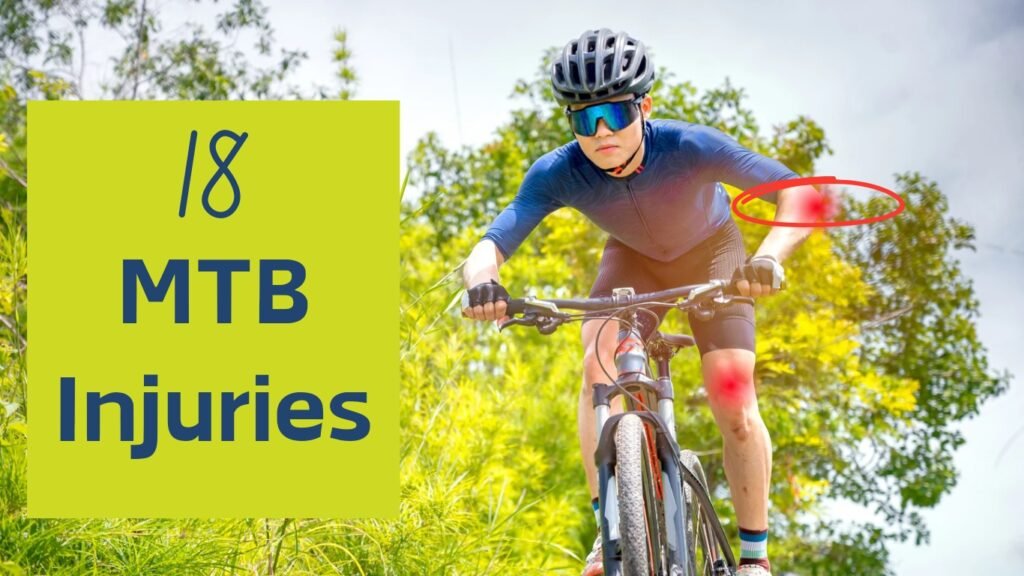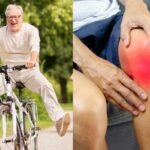Mountain biking is one of the most adventurous sports. That’s why it involves many risks of major and minor injuries.
All of these injuries can be prevented, and even if you get injured, you can recover instantly, but there are some serious injuries too that can bedridden you for weeks if you don’t take care of yourself while riding.

In this article, we will talk about the 18 most common mountain biking injuries and their prevention. Even if you ever get injured, then how will you recover? This guide will help you.
Also read: 14 Important safety tips for mountain bike rider
1. Knee Injuries (Patellar Pain, Tendonitis, Meniscus Tears)
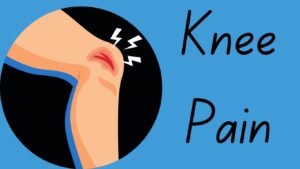
Knee injury is the most common complaint among many sports personalities, including mountain bikers.
However, in cycling, It happens due to poor bike setup or when you intensely climb hills.
This problem is also called Patellar tendonitis. To prevent this, you can adjust the saddle height so that your knee can slightly bend when you pedal. (Flat pedals or clipless pedals, which one should you choose)
Because when the saddle is too high, it stresses your knee.
How to prevent it:
You can also use clipless pedals, as these types of pedals are more efficient for pedaling motions and also reduce stress on your knees.
Besides this, you can do 5-10 minutes of warm-up with dynamic stretches such as lunges or leg swings before riding. This will help you prevent stiffness.
Furthermore, you also want to do some mountain biking strength training exercises to boost your endurance and reduce injury chances.
How to Recover:
Now, even if you have a knee injury problem, as I mentioned, you can stop riding immediately to recover from that.
After that, wherever you feel pain, apply ice for 15 to 20 minutes every few hours. When the pain subsides, then you can do some stretches like hamstring, quad stretches, etc.
Most importantly, if you don’t see any improvement, you want to seek professional help, probably from a physiotherapist; if the problem is serious, they may recommend an MRI to check for serious injury.
Do it only when you are not seeing any effect after applying ice and taking proper rest.
Also read: 27 of the best trails and destinations in the USA
2. Wrist and Hand Strains (Handlebar Palsy)
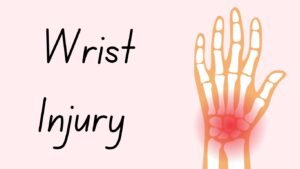
When you cover longer routes, you tend to have wrist or hand strains, especially when you spend a couple of hours gripping handlebars, and that too on rough trails. That’s why you feel pain, numbness, etc.
Hand Strain is also called handlebar palsy. It occurs due to constant pressure on the ulnar nerve of your palm, which causes tingling and weakness in your hand.
How to Prevent It:
The best way to prevent hand strains or handlebar palsy is to use padded gloves. They will reduce pressure on the nerves and cause vibration.
Besides this, you want to make sure the handlebars are at the right height and angle so that you can naturally hold them with your wrist.
Many bikers also make the mistake of holding the grip too tightly. So, you want to avoid it, especially on technical descent. Keep it a little loose.
How to Recover:
While riding, keep taking occasional breaks during the long ride to give rest to your overall body, hands, feet, etc. You can also use a splint to reduce irritation.
Besides this, you can try some wrist stretches like wrist flexors and light resistance exercises using a stretch ball.
You can also use massage therapy, like deep tissue massage, to get relief more quickly.
3. Shoulder Dislocations or Rotator Cuff Injuries

Shoulder injuries will occur whenever you fall or have an accident. Especially when you instantly extend your arms to break the fall.
Because of this, you can tend to have dislocation or rotator cuff tears.
How to Prevent It:
The prevention is really simple. Whenever you are falling, you should try to roll instead of just landing directly on your hand and shoulder.
This technique will reduce direct impact on your shoulder or anywhere else.
Besides this, you also want to do strength training and mountain biking exercises, especially those that involve shoulder rotations, as external rotation or overhead press is good, too.
Most importantly, you should wear shoulder pads to absorb impacts during fall, especially if you are a beginner or even a pro, but trying to ride on hard trails, you cannot just avoid safety gear at any cost.
How to Recover:
The shoulder injury might be serious, especially when you are wearing protective mountain biking gear and still have an injury in your shoulder.
In such a situation, you will need urgent medical attention. So, don’t try to pop it back in yourself. You want to visit a doctor as soon as possible. Doctors may recommend a test.
Besides this, they may also recommend physical therapy. So, after initial recovery, you can focus on mobility exercises like pendulum swings and then build strength slowly.
4. Lower Back Pain

If your posture is not good, or your core is weak, then you can have issues like lower back pain.
There are a few things in mountain biking that can cause and worsen the lower back, like a saddle.
How to Prevent It:
To prevent lower back pain, you want to make sure your bike is fit for you.
For example, the handlebar should be close enough to avoid overstretching and causing pain to your lower back; you should adjust the handlebar if you feel strained or uncomfortable.
Besides this, there are many exercises that build core strength for mountain biking. And you need to build it because the core will stabilize your spine.
Some exercises are dead bugs, planks, etc. Yoga is also good for stretching. You can do poses like cat-cow and child’s pose to loosen your lower back.
How to Recover:
If you already have lower back pain due to cycling, then you can consider having rest and heat therapy.
The heat will relax the tight muscles. You can use a heating pad after the ride.
Daily stretches that focus on the hamstring, hip flexor, and lower back are important too.
Also read: Right way to do Warm-up for Mountain biking
5. Ankle Sprains
Ankle sprains will occur if your foot mistakenly slips off from the pedal or If your feet get twisted during an awkward landing or falling.
How to Prevent It:
Avoid wearing regular shoes for mountain biking. Wear stiff-soled shoes with a good grip to get better support.
Besides this, don’t jump beyond your comfort zone until you do not have the proper skills. Do not copy pro riders if you are a beginner.
How to Recover:
To recover from ankle sprains, you can apply ice and rest. Compression and elevation are also good options to reduce swelling.
Plus, you can do some stretches to regain range of motion, such as ankle circles or resistance band stretches.
6. Concussions
A hard crash or accident can cause concussions, especially when you are not wearing a helmet. So you may feel dizziness, confusion, nausea, and headache.
How to Prevent It:
The best way to prevent any head-related problem is to always wear a helmet while riding a mountain bike.
Doesn’t matter on technical trails or simply on the road. You don’t want to take any risk with your head.
When you buy a mountain biking helmet, make sure that it has an MIPS sign available for extra safety. There are many types of helmets in the market, which may lead to confusion.
Besides this, don’t ride on expert trails if you are not ready. Most head injuries happen during the crash, and crashes happen when most beginner riders try to become pro riders quickly, try to take any shortcut, or are overconfident.
How to Recover:
To recover from concussions, you want to stop biking and also avoid extreme activities, etc, as long as the symptoms do not disappear.
Besides this, you can also seek a doctor’s help if symptoms are getting worse, like memory loss or prolonged dizziness.
Also read: How to choose the right MTB Helmet for your head safety (A complete guide)
7. Elbow Injuries (Tennis Elbow, Hyperextension, or Fractures)
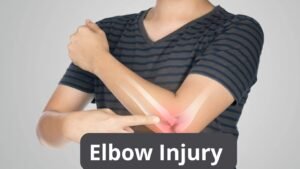
Elbow injuries happen due to three main reasons: repetitive grip, overextension during falls, and direct impacts.
Although there are a few more reasons, these are mainly for mountain biking.
A common problem is tennis elbow, which causes pain and inflammation due to overuse.
Sometimes, it can also involve hyperextension or fracture after a hard crash.
How to Prevent It:
To prevent this, you first want to pay attention to strengthening your forearms.
You can do exercises like wrist curls and reverse curls with a dumbbell or rod to make your forearm strong and prevent overuse injury.
You can also consider wearing elbow pads, especially on technical descents or park riding.
Plus, you need to relax your grip during rides to reduce unnecessary strain on your elbow joint.
How to Recover:
The recovery process is pretty simple. You want to apply ice for around 10-15 minutes every few hours.
Ice will reduce inflammation, and doing forearm stretches like light self-massage is a good option, too.
Moreover, you want to avoid riding as long as you are not able to grip handlebars without pain. If you don’t see any improvement, you want to consult a doctor.
8. Rib Fractures or Bruises
Rib injuries are also common during trail bike crashes because the chest hits the handlebar or sometimes rocks or roots on the ground.
Although it’s not life-threatening, it is very painful and sometimes even slow to recover, depending on multiple factors, like how fast you were riding and where you fell.
How to Prevent It:
The best way to prevent rib fractures and bruises is that you should avoid tackling obstacles that are not for you.
Suppose you are a beginner, so you shouldn’t directly jump to the trails that are designed for pro-level riders, no matter how confident you are.
Furthermore, you can also use chest protectors so that they can absorb impact, especially during downhill and enduro riding.
How to Recover:
To recover from rib fractures or bruises, you want to rest for at least 6 weeks. During that time, you should avoid heavy lifting and riding.
You can also consult a doctor to get painkillers, or further treatment of painkillers isn’t enough. Plus, you can also do proper breathing exercises every day to manage discomfort.
9. Hip Injuries (Contusions or Fractures)
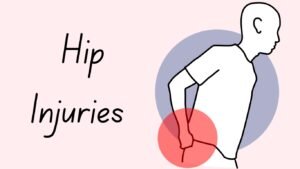
Falling or landing hard on one side can also cause hip injuries, also known as contusions, and sometimes even fractures, especially on rocky trails.
How to Prevent It:
To prevent hip injury, you want to develop some skills to handle bikes, especially on downhill riding and technical trails.
When you know how to maneuver your bike over obstacles and land correctly, you reduce crash risk. You can also wear padded shorts to absorb impacts when you crash.
How to Recover:
To recover from hip injuries, you want to rest and apply ice on the swelling for at least 15 minutes, 3-4 times a day.
If you don’t see any improvement, then you want to consult a physiotherapist cause you may have a fracture.
After that, they may recommend surgery or physical therapy to regain mobility and strength.
Also read: 10 Essential Tips for a Safe Ride
10. Facial Injuries (Cuts, Broken Teeth, or Fractures)
Facial injuries are common during a head-first fall and crashes into obstacles.
Most of the time, you get cut, break your teeth, and sometimes even fracture, especially when you are riding without any face protection.
How to Prevent It:
The simplest way to protect your face is always wearing a helmet, and there are many types of helmets that you can wear, such as half-shell and full-face.
I would particularly recommend a full-face helmet if you are into downhill and technical riding.
Besides this, you want to practice how to brake smoothly because sudden and improper brakes also cause crashes, which can result in facial injuries.
How to Recover:
If you ever get an injury on your face, you first want to clean the cut and see a dentist if the tooth is broken or you have any deeper wound.
They will treat your wound accordingly. Besides this, if you have a fracture or anything, you want to avoid riding and follow medical advice until you fully recover.
11. Shin or Calf Contusions (Pedal Strikes)
Shin or calf contusion is a minor injury that can often occur when you miss a pedal or hit it during a technical maneuver.
In pedal strikes, you get a little painful bruises or sometimes even cuts on the shin and calf.
How to Prevent It:
The best way to prevent any cut or problem on the shin is to wear a shin guard.
They will provide protection against stray pedal strikes. You can also use flat pedals with pins over the grip. They reduce the slip’s likelihood.
How to Recover:
To recover from the shin or calf injury, you first want to clean and protect the wound and treat cuts immediately to prevent any infection.
You can also have compression wraps to reduce swelling and speed your recovery from bruises.
12. Sprained Thumb (Skier’s Thumb)
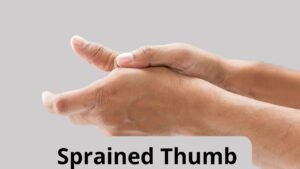
Sometimes, during the crash, if you land on your extended thumb, it can cause a sprain and sprain the ligament that is connecting your hand. This is also known as the skier’s thumb.
How to Prevent It:
You want to use proper gripping techniques to prevent sprained thumb problems.
For example, you shouldn’t wrap your thumb around the handlebar too tightly.
Plus, you should also wear gloves that are specifically designed to protect your thumb, as some gloves offer support to reduce sprains during impact.
How to Recover:
Body tapping is the best way to recover from an injured thumb. You can also use resistance bands to gradually rebuild strength when the pain is gone.
13. Eye Injuries (Debris, Scratches, or Infections)
Some debris, like dust, rocks, and branches, can also injure your eyes while riding.
Plus, you can also get infected by wearing dirty lenses or goggles. It’s a common problem.
How to Prevent It:
To avoid any eye injury, you want to wear clear glasses or goggles that protect your eyes from UV rays and also from debris.
Plus, you need to regularly clean goggles and glasses.
How to Recover:
After arriving from a ride, you want to flush your eyes with clean water or saline immediately, especially when debris enters your eyes.
If you see a little more serious problem, then you want to consult a doctor. Then they will treat you properly.
14. Neck Strain

Neck pain and stiffness are common during longer rides or whenever you keep your head in the same position (almost 60% people faces it).
Often, this problem is caused by poor posture or carrying a heavy load in a backpack.
How to Prevent It:
First of all, you need to correct your posture and make sure it aligns with the spine and your shoulders are relaxed.
Besides this, you should use a lite hydration pack to reduce strain. Too much weight is not good to carry in a backpack while riding a bike.
How to Recover:
You wanna stretch your neck regularly like chin tucks, and gentle slide tilts are good to relieve tension.
Plus, you can do a heat therapy, like applying a warm compress to relax tight neck muscles.
15. Foot Injuries (Plantar Fasciitis, Sprains)
The main cause of foot injuries is improper footwear, such as wearing regular sneakers on longer rides.
Because of this, you may face a problem called plantar fasciitis. It is characterized by common heel pain.
How to Prevent It:
The best way to prevent foot injuries is to wear proper shoes that are specifically designed for mountain biking.
Plus, you want to strengthen your foot by doing exercises like toe curls and calf stretches to prevent this.
How to Recover:
Rest and stretching are the best ways to recover from heel pain or knee pain.
16. Internal Injuries (Rare but Serious)
Internal injuries occur rarely; it happens, especially when you crash at a high speed. In these injuries, you may get organ bruises or bleeding.
How to Prevent It:
The best way to protect any internal or serious injury is to protect your torso.
For that, you can wear body armor, especially when you ride in extreme conditions that you haven’t ridden before, which are too risky, like the rocky downhill type.
Besides this, you want to be cautious on extreme trails. Plus, ride on the trail that matches your skill level and also avoid reckless speed.
How to Recover:
You want to call for an emergency or visit a doctor as soon as possible. And you don’t want to ignore it because it may worsen the situation.
17. Cuts and Abrasions (Road Rash)
Road rash is very common. Because whenever you slide out on a rocky trail, you can have painful scraps.
How to Prevent It:
Prevention is very simple. You first want to have the right mountain biking clothes.
For example, you can wear long sleeves and pants while making sure your clothes are lightweight, breathable, and made of breathable fabrics.
These types of clothes can reduce abrasion severity.
Plus, you also want to wear protective mountain biking gear such as knee and elbow pads to protect your body’s exposed area.
How to Recover:
Number one, you want to clean the wound whenever you fall. Plus, you want to use antiseptic and keep that area covered with a sterile bandage.
Furthermore, you also want to monitor for infection, such as you can watch for redness, swelling, or pus.
18. Groin Pain or Saddle Sores
Prolonged time in the saddle can also lead to discomfort and painful sores, and this problem is also known as “Saddle Sores.”
It happens because of friction, pressure, and moisture build-up in the area where your body contracts the saddle.
How to Prevent It:
First of all, you want to invest in a good saddle. The one which is designed for your riding style. Plus, you want to adjust its angle to avoid excessive pressure.
Along with this, you can also use chamois cream to reduce friction and prevent saddle sores.
How to Recover:
For recovery, you first want to take a break, so you do not ride until the sores heal completely.
Plus, hygiene is also important. You want to clean and disinfect the area to prevent any infection.
FAQs
Here are three FAQs about common mountain biking injuries, focusing on prevention and recovery:
What are the most common mountain biking injuries?
Some of the most common injuries that mountain bikers experience are wrist fractures and sprains, which happen when you outstretch your hand during falls.
The second common injury is a clavicle, also known as a collarbone fracture. It happens due to impact during the crash.
Concussions are also a serious injury that happens in the head when you do not wear a helmet and get injured. It’s really serious, and you need immediate medical attention.
Knee pain is also a problem that often happens due to overuse or trauma to the ligament. Besides this, cuts, scrapes, and bruises are also common but minor injuries.
How can I prevent common mountain biking injuries?
There are many things that you can do to prevent any mountain biking injury, whether it’s serious or common.
For example, you can invest in protective mountain biking gear like knee and elbow pads, helmets, and proper clothing such as full-sleeve clothes, jackets, etc.
Besides this, you can also warm up before riding so that you can prepare your muscles and joints.
More importantly, you want to progress gradually. Suppose you are a beginner, so you cannot directly jump onto the hard trails, which are specifically designed for expert or advanced riders; if you do so, chances will be high that you will fall.
Besides this, you want to make sure that your bike is a proper fit for you so that you can keep it in control.
You also want to stay hydrated and energetic; for that, you can eat snacks if you are on long rides, or you can keep drinking water during the ride.
Moreover, you need to do some strength training for mountain biking to develop endurance because when you are strong and have stamina and flexibility, you will have better control, stability, and reliance.
What should I do if I get injured while mountain biking?
First of all, you wanna have a small medkit whenever you go for longer rides or adventurous trails.
So, if you ever get injured while mountain biking, you first want to aid yourself for minor injuries like cleaning it and using a bandage, etc.
But if the injury is serious, like a head injury, severe pain, or suspected fracture, you will need to seek immediate medical attention.
For normal injuries, you can use a simple method known as RICE (Rest, Ice, Compression, and Elevation).
It’s really helpful for soft tissue injuries like sprains, strains, muscle soreness, etc.
So, for minor injury, you can stop riding, go back to your home, clean the wound, and take a rest until you do not recover.
If you don’t see any improvement, you want to visit a doctor for further treatment.
How can I strengthen my wrists for mountain biking?
The best way to make your wrist strong is to do exercise. You can do wrist curls and extensions with the help of lightweight or resistance bands.
It will help you strengthen your wrist and make it ready to absorb impacts and control your bike.
You can also practice squeezing a stress ball to improve better grip strength. Plank variation exercises are also good for challenging wrist stability.
Besides this, push-ups are good for your whole body, including shoulders, wrists, and other body parts.
Wrapping Up
Mountain biking is one of the most adventurous sports, and it is very interesting.
But you need to be cautious because it involves many injuries such as knee, wrist, head injury, bruises, cuts, etc.
However, if you prepare yourself and have enough knowledge, you can prevent all the risk of injuries.
For example, you can invest in good mountain biking safety gear to protect yourself whenever you fall, such as a helmet, knee pads, and good shoes for more comfort.
Besides this, you don’t want to directly start riding on advanced trails that are not designed for you.
You need to listen to your body; don’t keep riding even when you feel tired. You have to build endurance gradually if you want to cover longer routes.

Ali is the founder of Mountain Bike Insider and an passionate rider with years of hands-on experience in mountain biking. From testing gear to exploring trails, Ali writes based on real riding knowledge to help others make smart, safe, and enjoyable biking choices. Every guide is built on research, personal use, and a passion for the sport.

